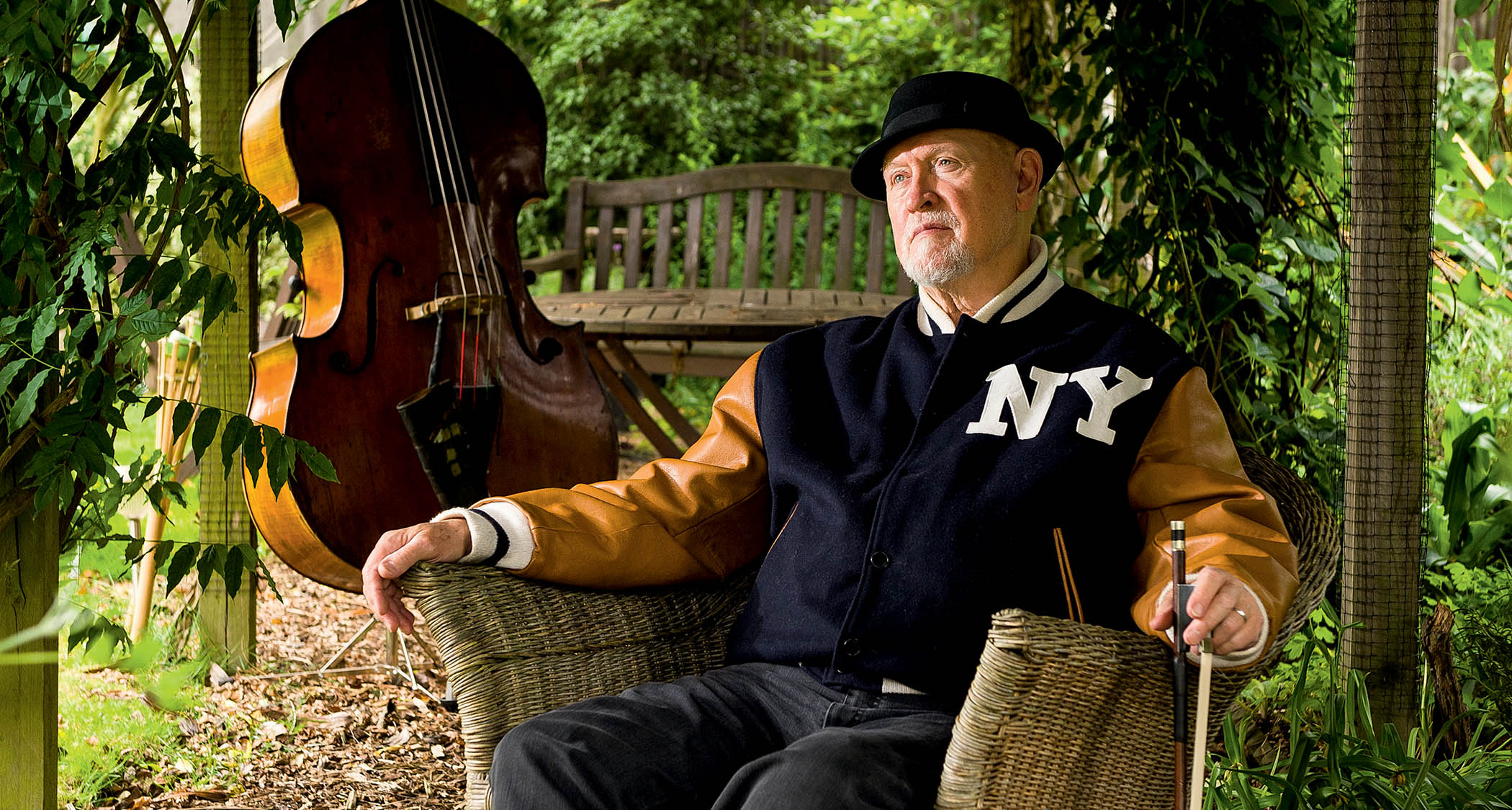Warren Haynes: Taking the Lead

Originally printed in Guitar World, December 2004
Master improviser Warren Haynes shows how to play a hot-shit solo over one-, two- and three-chord vamps.
As the driving force behind Gov’t Mule and an integral element in the current lineups of the Allman Brothers Band and the Dead, Warren Haynes is revered as a true 21st century guitar hero. In this exclusive backstage lesson, Haynes details some of the approaches he uses to create his characteristically brilliant, soulful improvised solos.
GUITAR WORLD Soloing is an essential element in rock guitar, but many players have a difficult time grasping how to do it.
WARREN HAYNES Here’s a good way to learn: set up a simple, repetitive groove on one chord, and then play different licks and spur-of-the-moment melodies over it. Once you’ve explored different ways to solo on one chord, add a second chord and make it a two-chord vamp. This will help you become accustomed to navigating back and forth between two chords. You can then expand to a three-chord pattern, a four-chord pattern and so on.
GW Can you give us some examples of soloing over a one-chord vamp?
HAYNES Sure. First, let’s set up a onechord groove, say, something based on D7#9 and played at a moderate tempo [FIGURE 1A]. The nice thing about D7#9 is that it contains both the major third, F#, and the minor third, F, which also functions as an augmented ninth. This allows a soloist a little more harmonic freedom, because you can utilize both the minor and major third within an improvised phrase.
All the latest guitar news, interviews, lessons, reviews, deals and more, direct to your inbox!
One way to solo over this chord is to play blues-based licks [FIGURE 1B]. This two-bar phrase is based entirely on D minor pentatonic [D F G A C]. Stylistically, it reflects the influence of some of my blues guitar heroes, such as Albert King and B.B. King. One could also use the minor blues scale, which adds the “flatted fifth” to the minor pentatonic [D minor blues scale: D F G Ab A C]. Blues-based phrases are effective and useful because they can be played over multitudes of chord changes and work like a charm.
GW How can a soloist expand from the blues palette?
HAYNES One way is to use a specific scale as the framework for soloing. If I want to accentuate the minor vibe of D7#9, I can play a line based on the D Dorian mode [D E F G A B C], such as this [FIGURE 1C]. The inclusion of the ninth and sixth [E and B] instantly change the mood and lend a darker feeling to the line.
I can also lean toward the majorsounding aspect of D7#9 by incorporating the major third, F# [FIGURE 1D]. Here, I use both the minor third, F, and the major third, F#, by first hammering from F to F# [bar 1, last two notes of beat three] and then bending F up one half step to F# [bar 2, downbeat of beat one].
GW Can one apply these approaches to a two-chord rhythm pattern?
HAYNES Absolutely. Let’s first set up a two-chord vamp [FIGURE 2A]. I begin with the same D7#9 chord but play it for one bar only, followed by one bar of G7. If we think of D as our home key, or tonic, D7#9 is the one [I] chord and G7 is the four [IV] chord, and this rhythm part supplies a repeated one-four [I-IV] chord progression for soloing.
Here’s a four-bar lick that sits across this repeated vamp [FIGURE 2B]. For the most part, this phrase stays within the realm of blues in the key of D, but I make brief reference to the four [IV] chord, G7, in bars 2 and 4, with the use of a B note, which is the major third of G.
Another way to utilize this same approach is to play something like this [FIGURE 2C]. In bars 1 and 3, I stick exclusively with D minor pentatonic; in bars 2 and 4, I incorporate the B note [D string/ninth fret in bar 2; G string/16th fret in bar 4].
I end this phrase with an Albert King–style two-step overbend, from F, the minor third, up to A, the fifth. Most bends are of the whole-step variety: for example, from C to D [FIGURE 2C, bar 1, beat one]. It’s important to have good control over your pitch centering, or intonation, when playing wider-than-normal bends, although bending a note slightly out of tune can create some nice musical tension.
Similarly, one can bend a note up one and a half steps, as blues great Freddie King would do when bending the fifth of the chord up to the flat seventh. In this lick [FIGURE 2D], I repeatedly bend A [high E string/17th fret] up one and a half steps, to C.
GW How do you approach soloing over more country-inspired material?
HAYNES If the music has a “country” flair, I’ll often utilize a straight major scale or a major pentatonic scale. For example, if I set up a two-chord vamp between D and G [FIGURE 3A], I can play lines like this [FIGURES 3B AND 3C], wherein I play phrases based on D major pentatonic [D E F# A B] over the D chord and use a few more notes from the D major scale [D E F# G A B C#] to play over the G chord. One can also analyze the licks played over G as being based on G major pentatonic [G A B D E].
Sticking with major pentatonic scales lends a very “happy” feeling to your phrases. You can bring variety into these kinds of phrases by using minor-flavored blues licks, as I do here [FIGURE 3D]. In this example, I’m playing majorsounding licks over the D chord and bluesier licks over the G chord. This way, I’m adding some dissonance to my happiness, or happiness to my dissonance, which is a reflection of what life’s all about. If I were to just play straight blues across this progression, I’d play something like this [FIGURE 3E].
The beauty of soloing is that there really are no rules. When playing over this D-G progression, you can stay with the D major scale the whole time, you can let the presence of the G chord influence your improvised melody a little bit or you can intentionally play right on each chord as it comes along. The best thing to do, in terms of musical freedom, is to incorporate all of these ideas.
GW How can one apply these techniques to a three-chord progression?
HAYNES It depends on the progression, of course. If I were to play a repeating Am-G-F progression [FIGURE 4A], I could stick with Am-type licks across all three chords, or I could melodically allude to the G and F chords to varying degrees.
Here’s an example of sticking with Am-type licks all the way through [FIGURE 4B]: with the exception of the brief use of a B note [last note of the pickup bar and bar 1, beat two, second note], the entire phrase is based on the A minor blues scale [A C D Eb E G].
If I want to follow the chord changes, I’ll do something like this [FIGURE4C]. As each chord comes along, I allow it to subtly affect the melody I play by targeting the appropriate triadic chord tones. Specifically, the notes of an Am triad are A, C and E, the notes of a G triad are G, B and D and the notes of an F triad are F, A and C. If I want to outline each chord as it comes along, I could do so by playing the notes of each triad individually, which is also known as arpeggiating[FIGURE 4D].
GW Can you give us some examples of three-chord progressions in which you kind of need to deal with each chord individually?
HAYNES D-G-C is one example [FIGURE 5A], because it can sound a little funny if you play only “D” licks across all three chords. I’d be more apt to play something like this [FIGURE 5B]. This way, I’m using an overall melodic approach—riding on the happy D major pentatonic vibe while including the triadic chord tones of C [C E G] and G [G B D]. I could take it a step further by utilizing the arpeggio approach, like this [FIGURE 5C].
Let’s try the same thing in the key to G, using a G-F-C progression [FIGURE 6A]. In this lick [FIGURE 6B], I’m combining all of the aforementioned approaches, utilizing G major pentatonic [G A B D E], the G major scale [G A B C D E F#], the triadic chord tones of G [G B D], F [F A C] and C [C E G], as well as chromaticism [a succession of notes one fret apart].
Another example of a three-chord progression in which you should play on each chord is Em-D-Am [FIGURE 7A]. In the key of E minor, the Am is known as the four minor [iv] chord, and the presence of this chord forces you to think a little differently. One way to navigate this progression is like this [FIGURE 7B]. While retaining a bluesy E minor feeling, I include triadic chord tones of D [D F# A] and Am [A C E]. Here’s another way to use this approach [FIGURE 7C].
All of these examples represent different ways I might approach soloing across some simple chord progressions. Hopefully, these examples will help guitarists to look at soloing from some new and different angles.
